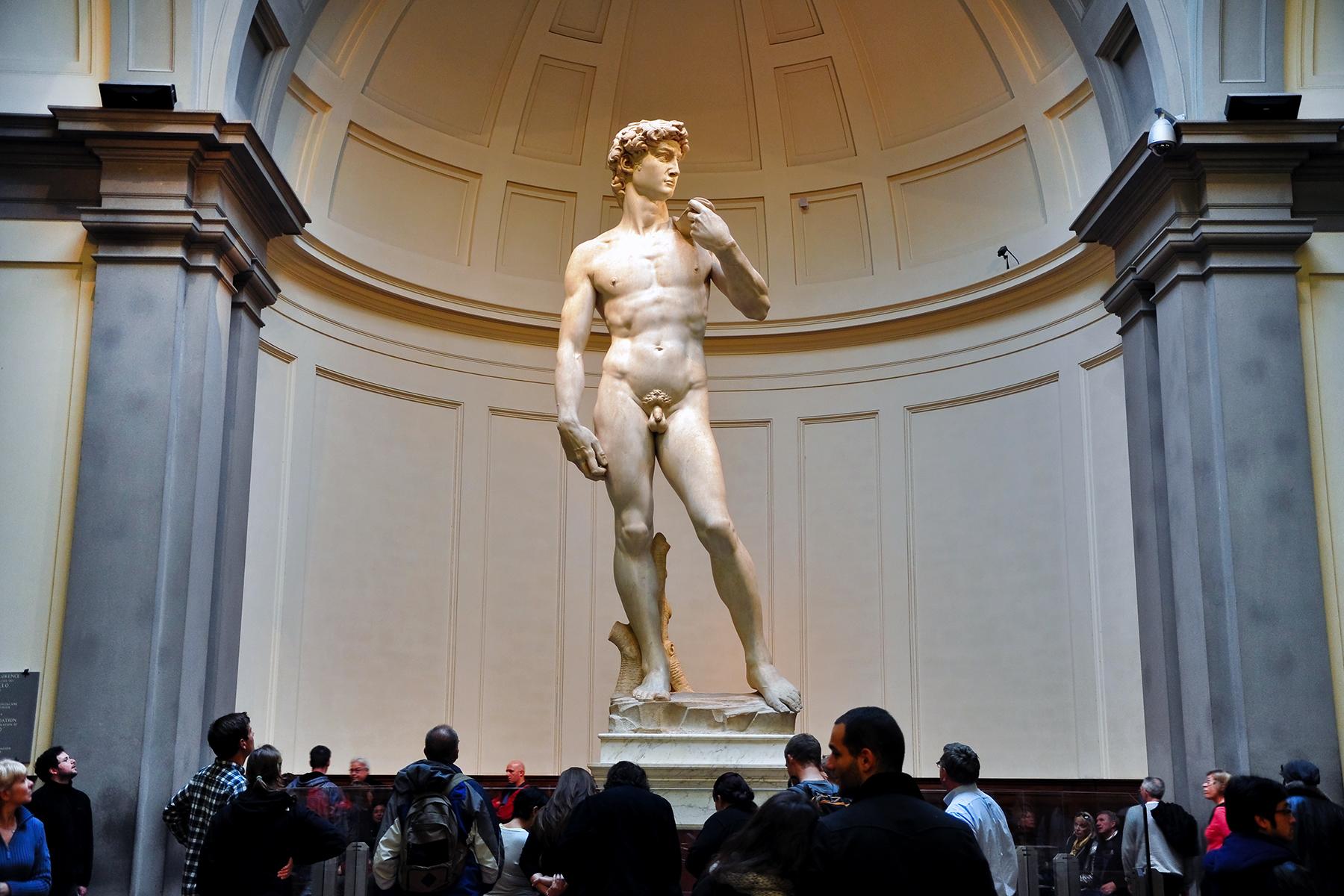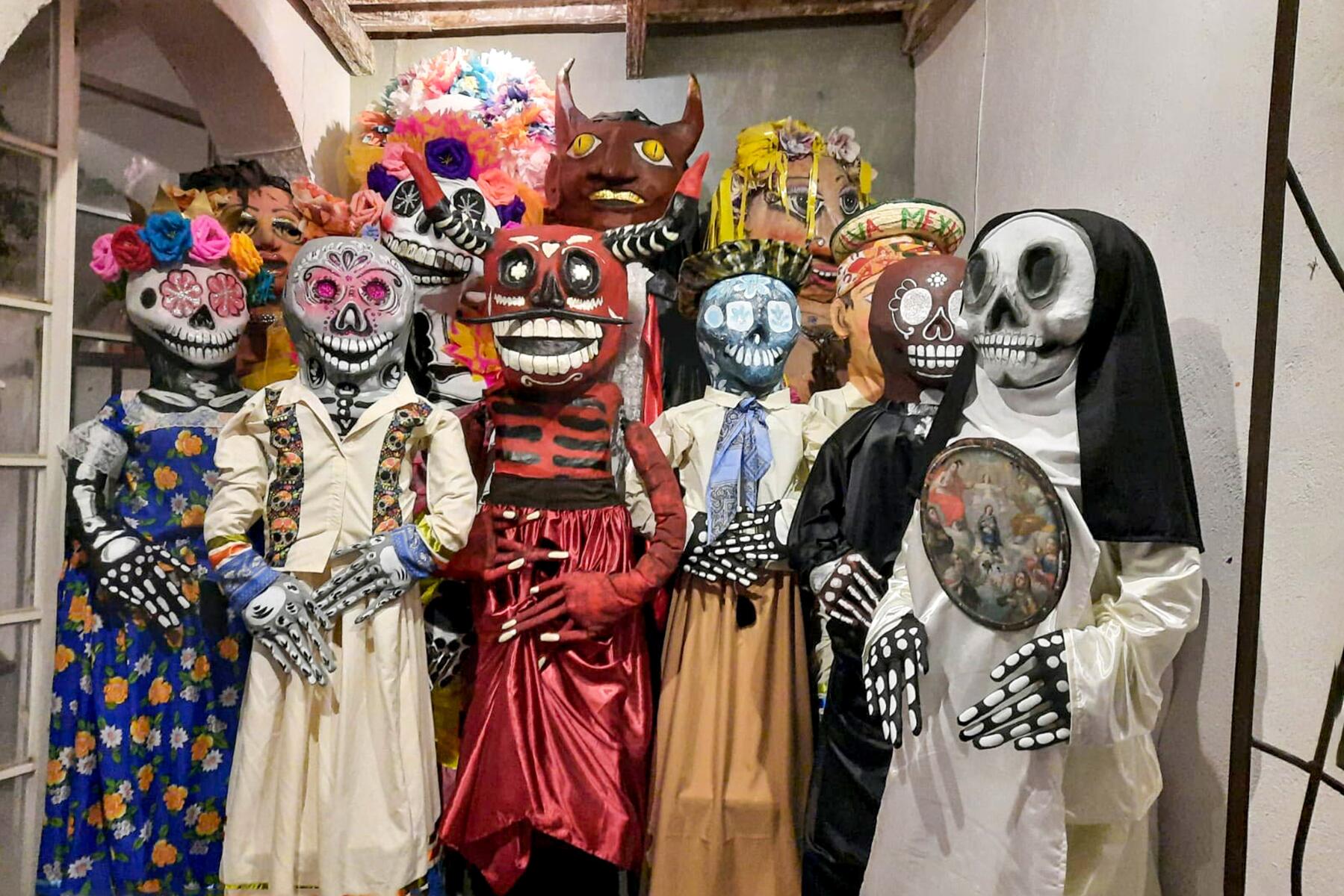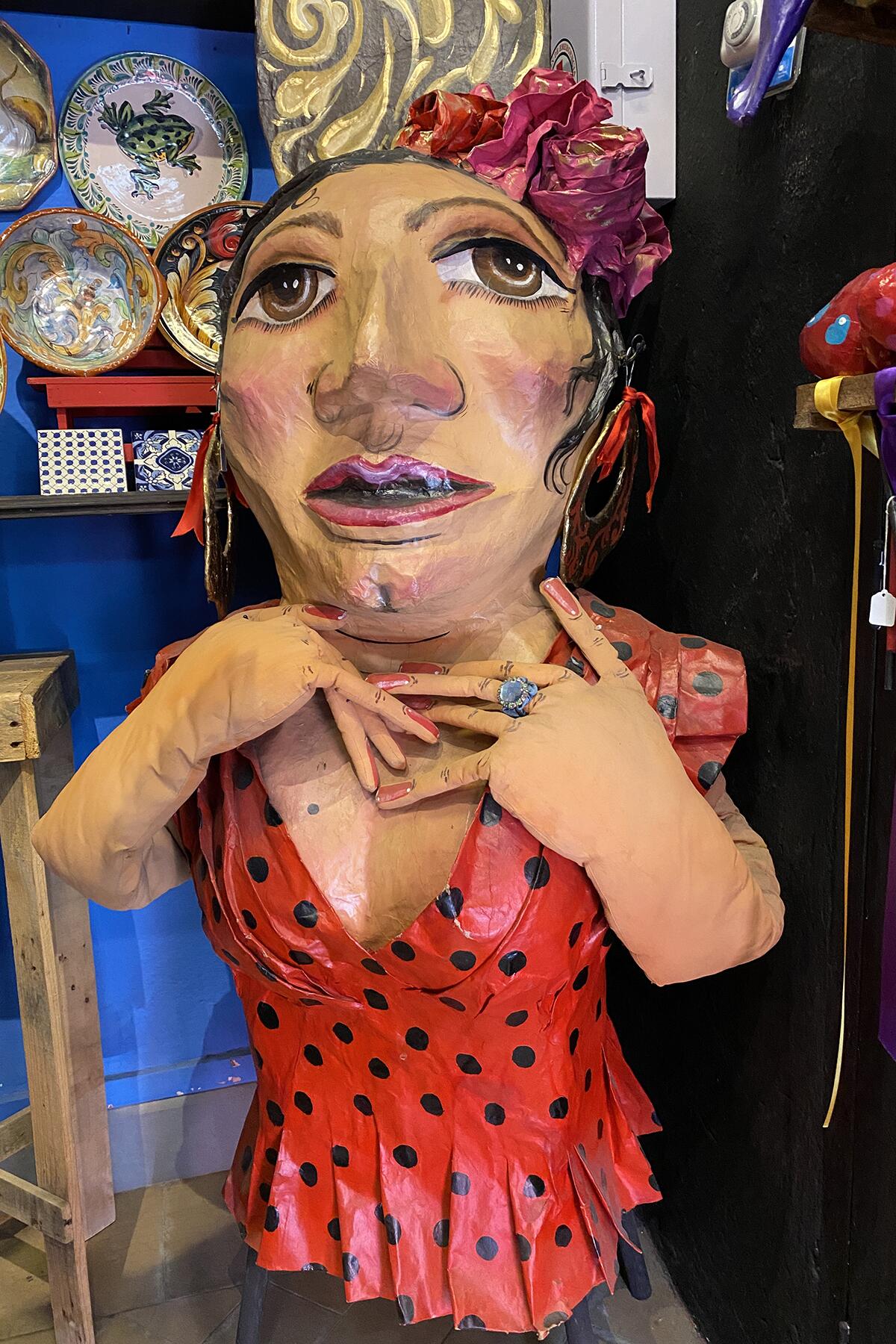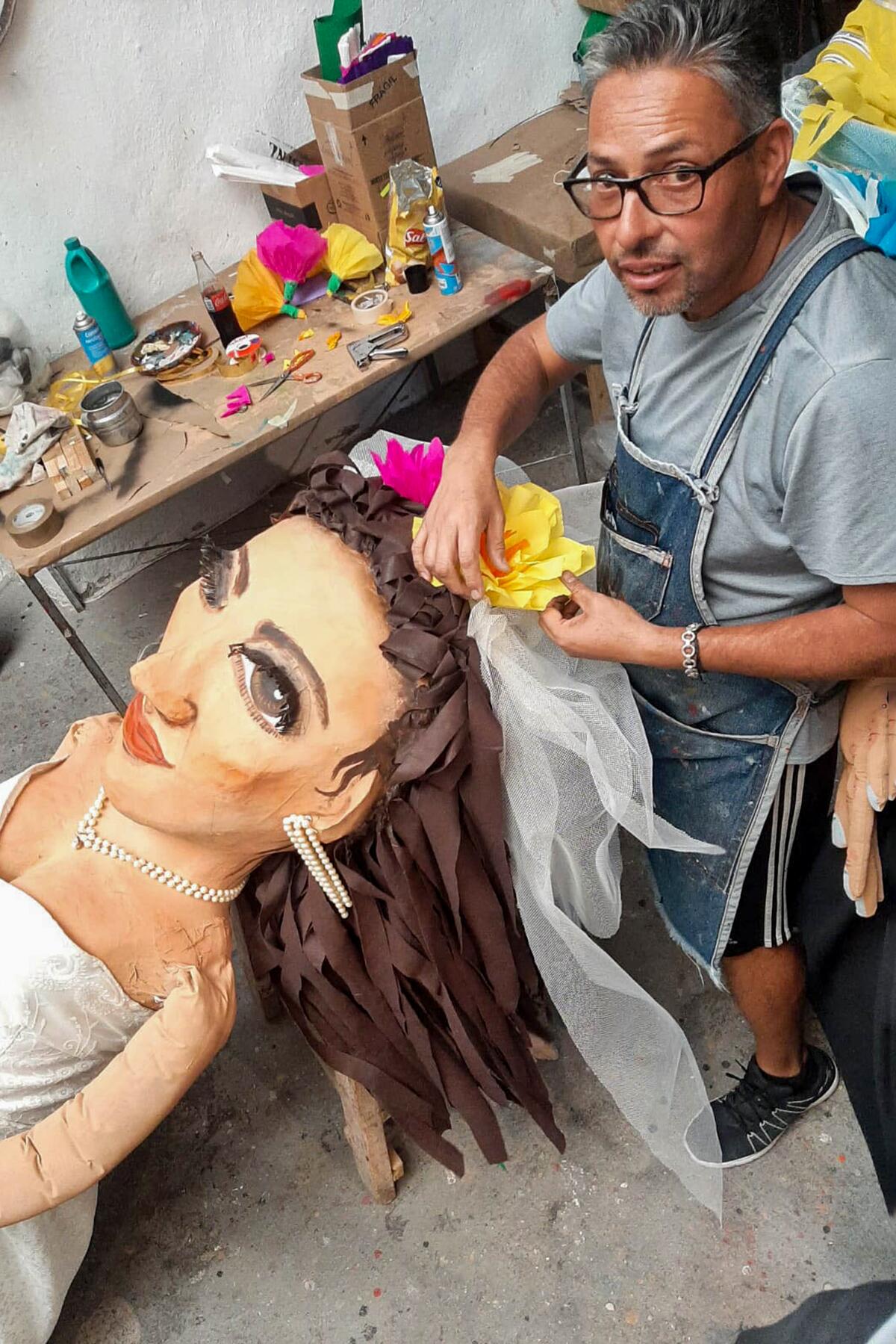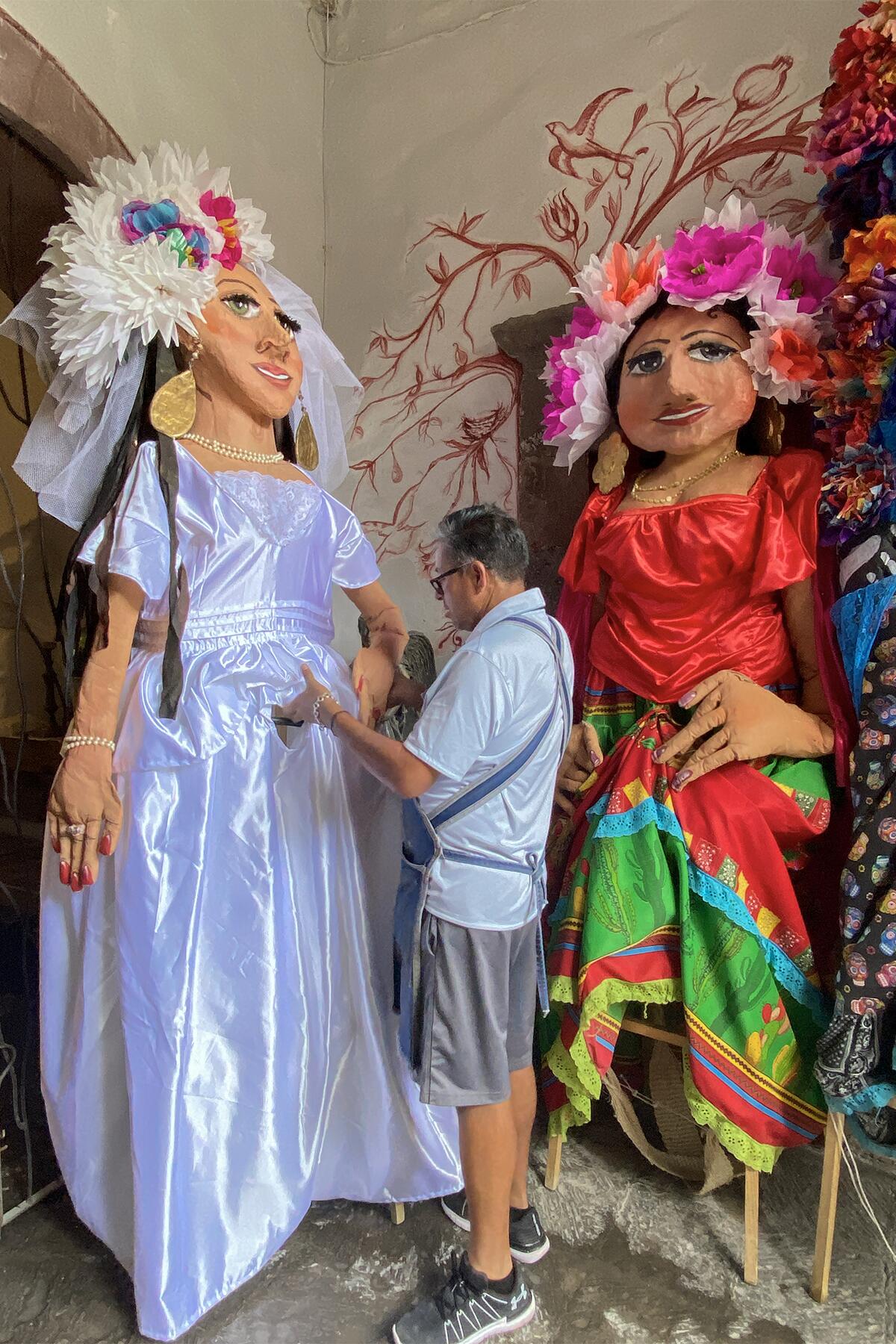On your next trip to Mexico, take a mohiganga workshop.
I
n the opening scene of the blockbuster James Bond movie, Spectre, you may notice the intriguing tall skeleton puppets and skeleton-clad dancers parading the cobblestone streets. Many of these puppets were created by a third-generation local Mexican artist who is one of the few carrying on this artisanal Mexican tradition.
Hermes Arroyo Guerrero is a world-renowned artist in San Miguel de Allende in México who makes mojigangas (giant puppet dolls with oversized heads and small bodies). Dancers wear the tall 3-D handmade puppet dolls at festivals and weddings all around Mexico. The papier-mâché and fabric puppets are especially popular during weddings, as bride and grooms have their faces imaged on the faces of the giant puppets, which the wedding party then parades along with the merrymaking crowds. You can also see dozens of these dolls at annual events held throughout Mexico, such as Dia de Muertos (day of the dead), Dia de Los Locos (day of the crazy), and La Quema de Judas (Burning of Judas) during holy week.
Arroyo, now 52, has been practicing this art since he was only seven years old. While growing up in San Miguel de Allende, he watched his grandparents and father create wooden sculptures of nativity figures and saints for religious events. They were santeros–ones who creates religious statues. As a young kid, he was more attracted to the festivities centered around the patron saint days, which included a lot of food and partying. Then he started dreaming about being among the imaginative figures and started making his own art.
Recommended Fodor’s Video
Arroyo apprenticed with his father’s coworker, master craftsman Genaro Almanza and learned to work with resin, plaster, wood, fabric, paint, and molds. At 18, he studied contemporary art in the city of Monterrey and at the Centro Cultural El Nigromante in San Miguel.
The celebrated puppet dolls were introduced to Mexico by the Spanish during the colonial period. Mojigangas (pronounced mo-he-gang-gas) were originally created for only religious events. Because of their enormous sizes, they were also referred to as mona de calenda and gigantes. Made with strong papier-mâché called “cartonería,” layers of fabric were drawn over a cane or wireframe for dancers to wear for public entertainment. The images of skeletons and demons paraded the streets and were burned after the events to symbolize the end of good and evil, life and death.
The dolls that stand 6-18 feet tall and weigh over 40 pounds dress in colorful costumes, wear eye-popping makeup and jewelry, and are animated with their gestures.
Arroyo’s creations, however, were never burned. He established a reputation for creating one of the most intricate personas, and his mojigangas began to grab the attention of artists, tourists, and collectors worldwide. His dolls were based on popular culture, with real-life symbolism. The characters were identifiable multicultural people with human-like expressions. The dolls that stand 6-18 feet tall and weigh over 40 pounds dress in colorful costumes, wear eye-popping makeup and jewelry, and are animated with their gestures. Arroyo draws on his experiences to make his mojigangas stand out, and buyers commission his orders for Hollywood movies, Grammy Awards, Mexican cultural festivals, and private parties.
While the art form can be seen around Mexico, Arroyo is the only one in his family who continued to evolve it and perhaps the only one in central Mexico who teaches it, as he is deeply engaged in preserving it as a cultural tradition of San Miguel.
He hosts free classes for kids and community members where he demonstrates how to build the puppets. For hotel and embassy guests, he offers custom-made private lessons. Travelers can also sign up for his workshops and make souvenir dolls when visiting San Miguel de Allende.
Taking a Puppet Making Class in San Miguel de Allende
Arroyo and his sister offer two types of classes at their childhood home which doubles as a studio and a gift shop called Tienda Mojigangas 62. During the five-day long extensive class, students can make six feet tall mojigangas, working for a couple of hours each day. And in a three-hour intensive workshop, visitors can learn to make a smaller, 15-inch-tall portable version of the dolls they can take home in their suitcases. Classes last for a couple of hours each day, cost between 1000-3000 Mexican pesos (USD 50-150), and can accommodate one to eight students.
With the assistance of his English-speaking nephews as translators, Arroyo invites everyone to visualize their end product by sketching it out on paper first. This describes the face (many people create their own personas), as well as their hair, clothes, and accessories. Besides yourself, you can also draw priests and political figures, objects (such as helicopters), pets, skeletons, or alajibre (mythical Mexican animals).
Then, a basic mold of the doll is created using craft paper. The structures are formed by layering the paper and gluing it together using a damp paste called engrudo, a material made with flour and hot water. His sister, Valeria, helps him dissolve, boil, assemble and glue the papers together until they thicken like cardboard.
To shape the paper into different forms–faces, hands, legs, and torsos, the paper is rolled into balls and assembled in pieces until it resembles parts of the body. After the mold is created and glued together, it is dried using a blow dryer to speed up the process. For the multiple-day classes, the molds are dried in the sun for an entire afternoon and up to a day.
The next step involves painting the dolls with bright or pastel-colored acrylic paint, paint powder mixed with water, as well as a diluted plastic art glue. Using Arroyo’s own paints and brushes that he uses to create masterpieces, the entire mold of cardboard paper is colored and then dried off.
The last step in this mixed-media creation involves putting a glossy varnish to give the dolls a finer and more durable finish. Then the students visit Arroyo’s packed wardrobe and accessory closets to pick out colorful, tailored attires, flower headdresses, statement necklaces, and more. Funky oversized wigs and bridal veils are also added to humor and humanize the dolls.
Mojigangas can traditionally be found in central Mexico, primarily in the states of Guanajuato, Michoacán, Guerrero, and Oaxaca, where they entertain tourists and locals, threading together history, art, and a sense of community.


